Part 4: Presenting financial performance information
4.1
Financial performance is an important element of a local authority's overall performance. It is therefore important to analyse financial performance when assessing local authority performance. In annual reports, the financial performance information is found in the financial statements and notes to the financial statements. The cost of service statements15 are found in the SSP at the "group of activity" level.
4.2
Financial statements have to be prepared in keeping with New Zealand generally accepted accounting practice and therefore need to follow the financial reporting requirements of NZ IFRS. NZ IFRS is prescriptive about the form of the financial information and the nature of the disclosures required. However, financial statements also need to be relevant and appropriate for financial accountability purposes. Financial statements are made publicly available to partly fulfil a local authority's accountability responsibilities.16
4.3
It is important that financial performance information can be readily integrated with non-financial performance information. This is because true accountability requires transparency about both financial and non-financial performance and an appropriate relationship between the two.
4.4
Ideally, the financial performance information should communicate a local authority's performance compared with the financial strategy that it sets in its LTP. Clause 36 of Schedule 10 of the LGA requires local authorities to include a statement in their pre-election report that compares the rates, rate increases, and borrowing within the quantified limits specified in the financial strategy. Therefore, financial information should be presented simply and should not require a reader to have expertise in analysing the financial statements.
4.5
We found that the quality of financial performance reporting at the group of activity level had improved over time and most noticeably in the 2009/10 annual reports. Local authorities placed more emphasis on "telling the performance story", particularly in the narrative explaining significant variations between budgeted and actual performance and the effect that the variations have had on service performance.
4.6
Local authorities often included a high-level analysis of performance in the reports provided by the mayor (or chairperson) and the chief executive. Although practices varied between local authorities, the comments in the high-level analysis typically focused on key issues and impacts, and key achievements for the financial year. Such commentary is an important aspect of performance reporting and improves the usefulness of information provided to the ratepayers, the community, and the general public.
4.7
We provide examples of better reporting practice in two areas:
- financial summaries; and
- key performance trends.
Examples of better reporting practice – financial summaries
4.8
We consider that Wellington City Council's 2009/10 annual report showed better practice in explaining its financial performance information. Its annual report included a seven-page financial overview section17 The reporting attributes that we liked included:
- An explanation of the terminology used in the financial statements. For example, "Total income – total expenses = net surplus" to help in understanding the financial statements.
- A bar graph showing total income, expenses, and net surplus for the last three years. This is an example of longitudinal reporting (although trends are more evident when information is presented over a longer time frame of at least five years).
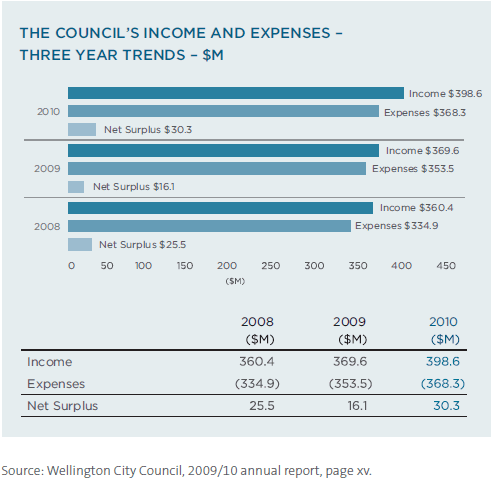
- Funding for capital expenditure and activity operating income being analysed and reported using pie charts.

- Including brief comments to aid the reader's understanding of the graphical information. For example: "We record this amount [capital funding] as income even though it is not used to fund operating activities." This statement was further explained with: "The income from the New Zealand Transport Agency is used to help fund capital expenditure on the Council's road corridor …". These two statements told the reader why a net surplus was reported for 2009/10 and the story of how it came about.
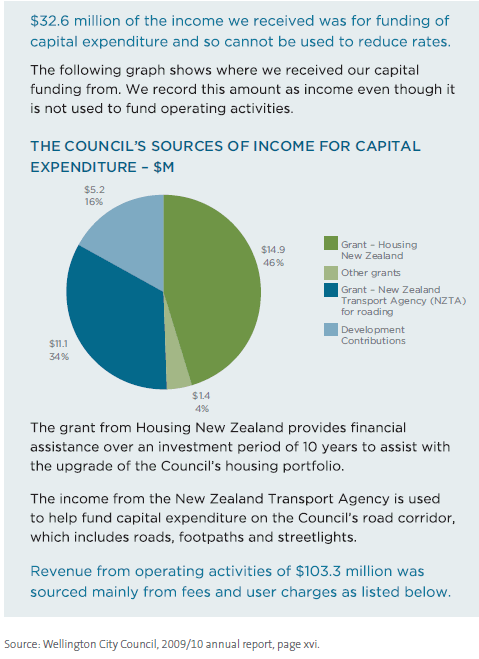
- A graphical analysis of total assets and total liabilities for the last three years.
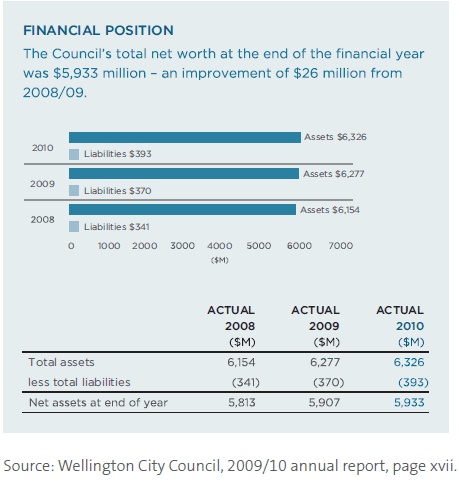
- Breakdown of capital expenditure by strategy (group of activities).
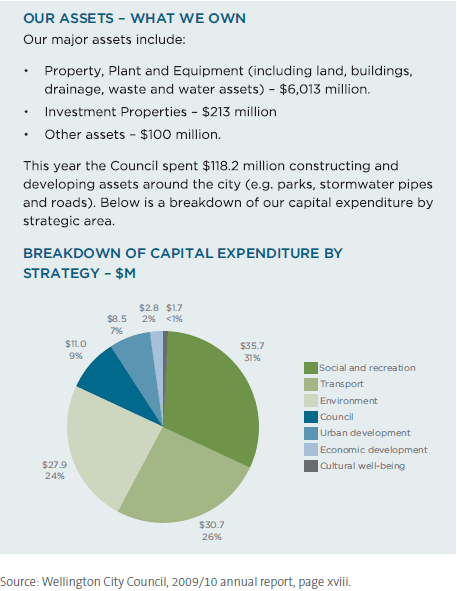
- Analysis of key financial ratios (borrowing and liquidity) being reported against the internal policy limits – for example, borrowings as a percentage of equity, borrowings as a percentage of income, and net interest as a percentage of annual rates income.
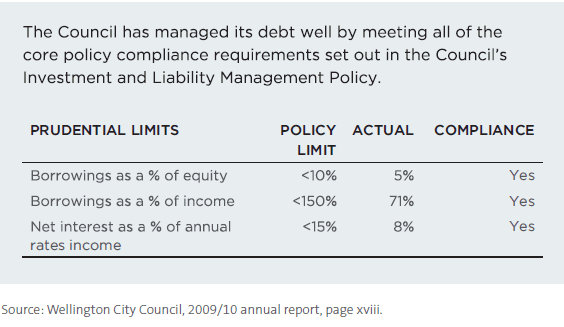
4.9
We also consider that Environment Canterbury's "financial commentary" section in its 2009/10 annual report showed two particularly good features in terms of reporting financial performance information.
4.10
Environment Canterbury stated: "For every $100,000 of capital value, the owner of a property in the Canterbury region paid an average of $33.52 in general rates to Environment Canterbury." A diagram supports this statement, showing the activities to which the $33.52 had been applied (see Figure 15). We consider this a useful piece of analysis because it provided information that every ratepayer could directly relate to.
Figure 15
How the $33.52 in general rates for every $100,000 of capital value had been spent on various Environment Canterbury activities
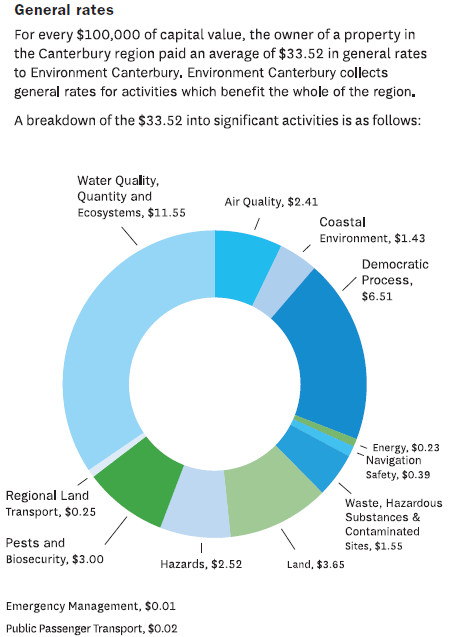
Source: Environment Canterbury, 2009/10 annual report, page 38.
4.11
Environment Canterbury reported a number of key financial statistics and financial performance items for a seven-year period, with explanatory comments (see Figure 16). This is a good illustration of reporting trends.
Figure 16
Key financial statistics and financial performance items for Environment Canterbury over a seven-year period
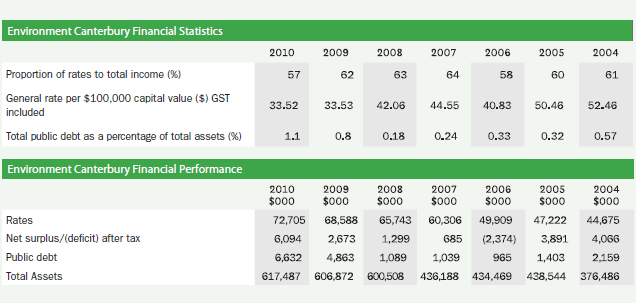
Source: Environment Canterbury, 2009/10 annual report, page 38.
4.12
Environment Canterbury could include further analysis and comment on the general rate per $100,000 of capital value and use that as a proxy to assess overall efficiency and cost-effectiveness of its operations. A decreasing ratio could indicate that services are being performed more efficiently. However, to complete this analysis, the movements in capital values, and impacts and outcomes of services provided, would need to be evaluated.
Examples of better reporting practices – key performance trends
4.13
Local authorities regularly use a suite of common financial ratios and benchmarks to assess their financial performance. In some instances, they also assess their performance against other local authorities of a similar size and nature. Traditional performance indicators focus on profit and returns on investment, which are not applicable to local authorities whose primary objective is to provide services for the community or for a social benefit. However, there are key financial performance ratios that local authorities should consider because ratios provide a point-in-time picture of financial performance from other angles. Figure 17 summarises a set of financial performance indicators that we believe are useful for comparing performance over time. We drew many of these from the Wellington City Council and Environment Canterbury annual reports.
Figure 17
Key financial performance indicators
| Key financial performance indicator | Reason for using the indicator |
|---|---|
| Rates as a percentage of total income. | This demonstrates how dependent the local authority is on rates income to fund its activities or, conversely, how dependent the local authority is on other sources of income (for example, dividend or investment income). |
| Percentage rates increase year-on-year over time. Complementary indicators might include: - rates per head of population; and - rates per rating unit. |
This measures fiscal prudence, although results would need to be considered in the context of the local authority's circumstances (for example, the local authority's financial strategy). |
| Percentage increase in the cash flow from operating activities year-on-year over time. (Operating activities are the principal revenue-producing activities of the local authority and exclude activities relating to long-term assets and other investments, equity, and borrowings.) |
This measures fiscal prudence, although results would need to be considered in the context of the local authority's circumstances (for example, the local authority's financial strategy). |
| Capital expenditure as a percentage of the depreciation charge. | This measures whether the local authority is expanding its levels of service, catching up on deferred capital expenditure, deferring capital expenditure, or spending on a business-as-usual basis. Further information would be needed to show which of these applies. |
| Funding sources for capital expenditure. | This shows how capital expenditure is funded (for example, rates, government grants and subsidies, cash reserves, or borrowings). |
| Average percentage return on investments. | This measures the effectiveness of investment decisions. |
| Average percentage borrowing cost. | This measures the cost of borrowing as a financial strategy. |
| Key borrowing ratios. For example: - borrowings as a percentage of rates; - the number of times interest is covered by rates; and - borrowings as a percentage of total assets or total equity. |
These measure the capacity to borrow and ability to service and support borrowings. |
| Working capital (or current) ratio. | This measures the extent to which the local authority can meet its short-term obligations (for example, payments to creditors, employee entitlements, or short-term borrowings). |
4.14
It may be worthwhile presenting the above ratios or other financial information using graphs to show the trends. These graphs should be accompanied with commentary. For example, a local authority could graph the trends of operating expenditure, rates income, and total income as a pictorial overview of financial performance. A pictorial overview of the local authority's financial strategy could be shown by graphing the trends of capital expenditure, investment assets, and borrowings. Figure 18 sets out our graphing of Matamata-Piako District Council's operating expenditure, rates income, borrowings, investments, and capital expenditure over seven years.
Figure 18
Matamata-Piako District Council's operating expenditure, rates income, borrowings, investments, and capital expenditure from 2003/04 to 2009/10
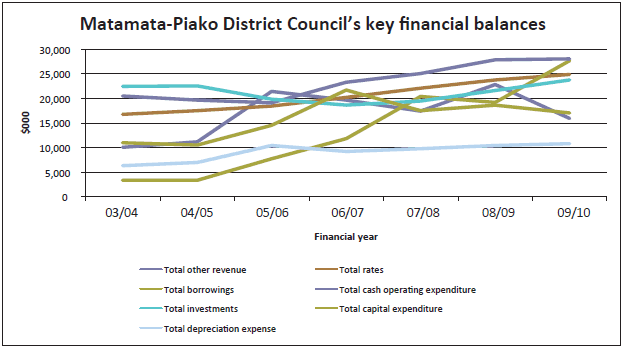
4.15
The trends in the graph indicate the following:
- There has been an increase in most activity areas as reflected in the upwards trend in rates revenue, other revenue, cash operating expenditure, capital expenditure, borrowings, and investments.
- Based on the levels of cash operating and capital expenditure trends, Matamata-Piako District Council appears to be increasing the scope (or the level) of services it provides to its community.
- Capital expenditure is at least twice the depreciation expense in each of the seven years. This could indicate either increases in the level of services or catching up on expenditure deferred from previous years, but providing additional information would make this clearer.
4.16
Matamata-Piako District Council appears to have changed how it funds its activities. Over the seven years, while the level of borrowings has increased, the investments balance has been maintained. This indicates that investments are not being used as a funding source for its activities. We found that this part of its decisions had not been communicated in the annual reports and should be considered, particularly to explain the funding approach for significant capital projects.
4.17
We have analysed and commented on what we believe is Matamata-Piako District Council's financial strategy based on what is reflected in the performance results. It is an exercise that Matamata-Piako District Council and other local authorities should consider doing in their future annual reports to show that they are using historical performance information as part of making business operating decisions. As mentioned earlier, local authorities will need to report against their financial strategy in their pre-election report.
4.18
An important focus of the upcoming 2012-22 LTP will be the disclosure of the local authority's financial strategy. Therefore, it is useful and good practice for local authorities to include analysis and commentary in the annual report reflecting how they have performed compared with their financial strategy. Wellington City Council's financial overview section in its 2009/10 annual report included a number of useful graphs and comments about its financial strategy. Figure 19 sets out part of those comments.
Figure 19
Part of Wellington City Council's narrative about its performance against its financial strategy
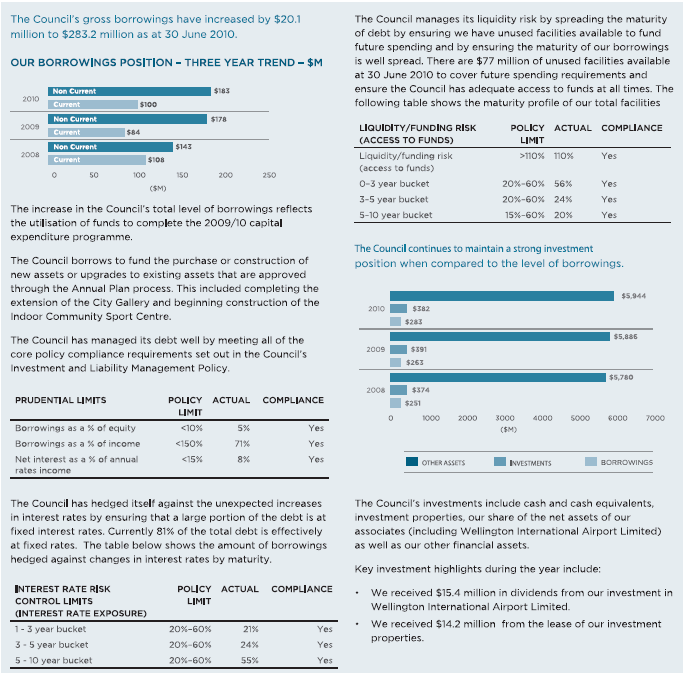
Source: Wellington City Council, 2009/10 annual report, pages xviii and xix.
4.19
Lack of analysis and commentary would make it difficult for a reader to understand why and how a local authority has made its financial management decisions. To inform its readers, it is worthwhile for a local authority to clearly communicate its financial strategy, explain any significant variances in its annual report, and relate its financial performance to the financial strategy.
| Recommendation 3 |
|---|
| We recommend that local authorities include financial performance summaries that focus on the key issues and impacts, and key achievements during the financial year and over longer terms to reveal performance trends. |
| Recommendation 4 |
|---|
| We recommend that local authorities use graphs, diagrams, and other visual presentations to show performance, and support these with narrative and commentary as part of the context. |
| Recommendation 5 |
|---|
| We recommend that local authorities consider reporting against key financial performance indicators to benchmark their performance and for assessing performance over time and against their financial strategy. |
15: The cost of service statements will be the funding impact statement from the 2012/13 annual reports.
16: Controller and Auditor-General (June 2009), The Auditor-General's views on setting financial reporting standards for the public sector, page 35.
17: Wellington City Council, 2009/10 annual report, pages xiv-xx. This report is available at http://www.wellington.govt.nz/plans/annualreport/0910/index.html
page top